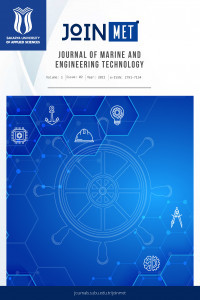Modeling of Diesel Engine Performance and Emission Using Artificial Neural Networks
Diesel engine, performance, emission, artificial neural networks
___
- [1] A. Ekmekçioğlu, S. L. Kuzu, K. Ünlügençoğlu, and U. B. Çelebi, “Assessment of shipping emission factors through monitoring and modelling studies,” The Science of the total environment, vol. 743, 2020.
- [2] M. T. Islam, F. Rashid, and A. Arefin, “Numerical analysis of the performance and NOx emission of a diesel engine fueled with algae biofuel-diesel blends,” Energy Sources, Part A: Recovery, Utilization and Environmental Effects, 2021.
- [3] G. Gonca, “Investigation of the influences of steam injection on the equilibrium combustion products and thermodynamic properties of bio fuels (biodiesels and alcohols),” Fuel, vol. 144, pp. 244–258, 2015.
- [4] G. Gonca, “Effects of engine design and operating parameters on the performance of a spark ignition (SI) engine with steam injection method (SIM),” Applied Mathematical Modelling, vol. 44, pp. 655–675, Apr. 2017.
- [5] M. K. Deh Kiani, B. Ghobadian, T. Tavakoli, A. M. Nikbakht, and G. Najafi, “Application of artificial neural networks for the prediction of performance and exhaust emissions in SI engine using ethanol- gasoline blends,” Energy, vol. 35, no. 1, pp. 65–69, 2010.
- [6] B. Maaß, R. Stobart, and J. Deng, “Diesel engine emissions prediction using parallel neural networks,” Proceedings of the American Control Conference, pp. 1122–1127, 2009.
- [7] H. Sevinc and H. Hazar, “Determining the effects of 2-ethylhexyl nitrate blend on isolated diesel engine attributes using the experimental and ANN approaches,” Energy Sources, Part A: Recovery, Utilization and Environmental Effects, 2019.
- [8] Q. Zhang and D. Tian, “Study of CWS/diesel dual fuel engine emissions by means of RBF neural network,” in Asia-Pacific Power and Energy Engineering Conference, APPEEC, 2010.
- [9] P. Shanmugam, V. Sivakumar, A. Murugesan, and M. Ilangkumaran, “Performance and Exhaust Emissions of a Diesel Engine Using Hybrid Fuel with an Artificial Neural Network,” Energy Sources, Part A, vol. 33, pp. 1440–1450, 2011.
- [10] G. Mao, C. Zhang, K. Shi, and P. Wang, “Prediction of the performance and exhaust emissions of ethanol-diesel engine using different neural network,” Energy Sources, Part A: Recovery, Utilization and Environmental Effects, vol. 0, no. 0, pp. 1–15, 2019.
- [11] D. Babu, V. Thangarasu, and A. Ramanathan, “Artificial neural network approach on forecasting diesel engine characteristics fuelled with waste frying oil biodiesel,” Applied Energy, vol. 263, no. February, 2020.
- [12] S. Raghuvaran, B. Ashok, B. Veluchamy, and N. Ganesh, “Evaluation of performance and exhaust emission of C.I diesel engine fuel with palm oil biodiesel using an artificial neural network,” Materials Today: Proceedings, no. xxxx, 2020.
- [13] R. Kenanoğlu, M. K. Baltacıoğlu, M. H. Demir, and M. Erkınay Özdemir, “Performance &emission analysis of HHO enriched dual-fuelled diesel engine with artificial neural network prediction approaches,” International Journal of Hydrogen Energy, vol. 45, no. 49, pp. 26357– 26369, 2020.
- [14] M. İ. ÖZMEN, Ö. CİHAN, A. KUTLAR, O. A. ÖZSOYSAL, and C. BAYKARA, “Modelling A Single-Rotor Wankel Engine Performance With Artificial Neural Network At Middle Speed Range,” International Journal of Automotive Science And Technology, vol. 4, no. 3, pp. 155– 163, 2020.
- [15] M. Aydın, S. Uslu, and M. Bahattin Çelik, “Performance and emission prediction of a compression ignition engine fueled with biodiesel-diesel blends: A combined application of ANN and RSM based optimization,” Fuel, vol. 269, no. February, 2020.
- [16] K. Ramalingam et al., “Forcasting of an ANN model for predicting behaviour of diesel engine energised by a combination of two low viscous biofuels,” Environmental Science and Pollution Research, vol. 27, no. 20, pp. 24702–24722, 2020.
- [17] J. Castresana, G. Gabiña, L. Martin, and Z. Uriondo, “Comparative performance and emissions assessments of a single-cylinder diesel engine using artificial neural network and thermodynamic simulation,” Applied Thermal Engineering, no. October, p. 116343, 2020.
- [18] C. S. Lage, S. de Morais Hanriot, and L. E. Zárate, “Using artificial neural networks to represent a diesel–biodiesel engine,” Journal of the Brazilian Society of Mechanical Sciences and Engineering, vol. 42, no. 11, pp. 1–12, 2020.
- [19] P. Madane and R. Panua, “Investigation of Performance of jatropha oil on diesel engine using Artificial Neural Network Model .,” pp. 522–528, 2018.
- [20] K. s. v and S. K. Masimalai, “Predicting the performance and emission characteristics of a Mahua oil-hydrogen dual fuel engine using artificial neural networks,” Energy Sources, Part A: Recovery, Utilization and Environmental Effects, vol. 42, no. 23, pp. 2891–2910, 2020.
- [21] M. KARAGÖZ, “ANN Based Prediction of Engine Performance and Exhaust Emission Responses of a CI Engine Powered By Ternary Blends,” International Journal of Automotive Science And Technology, vol. 4, no. x, pp. 180–184, 2020.
- [22] C. Kaya, Z. Aydin, G. Kökkülünk, and A. Safa, “Exergetic and exergoeconomic analyzes of compressed natural gas as an alternative fuel for a diesel engine,” Energy Sources, Part A: Recovery, Utilization and Environmental Effects, 2020.
- Başlangıç: 2021
- Yayıncı: Sakarya Uygulamalı Bilimler Üniversitesi
Effect Of Ship Doors In Emergency Situations
İbrahim BAKACAK, Hakan Serhad SOYHAN
Modeling of Diesel Engine Performance and Emission Using Artificial Neural Networks
AHP And Grey Relations Analysis Based Boat Selection For Summer Tourism Activities
Muhammet Enes AKPINAR, Mustafa GERŞİL
Optimization Of The Laser GMA Hybrid Welding Parameters Using Genetic Algorithm
Ömer Faruk DEMİROK, Osman ÜNAL
An Overview of Environmental Impacts and Treatment Systems of Ship Ballast Waters
Mehmet DOĞRU, Seyid Mahmud Esad DEMİRCİ, Refik CANIMOĞLU, Hüseyin ELÇİÇEK
